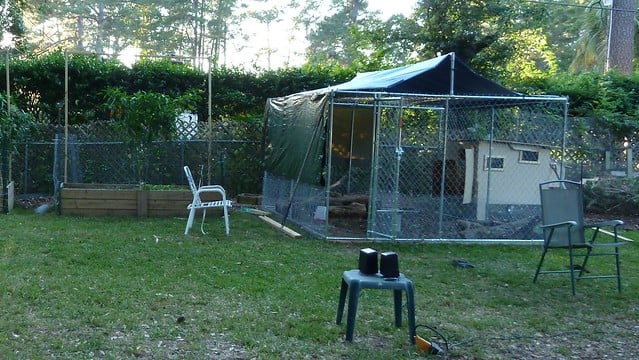I really do not recommend making electric fencing your MAIN predator deterrent. Even if correctly installed and checked daily, which relatively few people do the first of those and hardly anyone does the second, it still fails occasionally for a variety of causes and predators can be real quick to notice. It *is* a good "cherry on top" of an already reasonably predatorproof setup.
IMO for most purposes an undiggable apron at least 18" wide (wider if you have known digging-predator problems), securely butted/attached to the outside foot of the run fence, is the most sensible option. People most commonly use HEAVY-gauge galvanized wire fence mesh, no larger than 2x4 mesh (there is really not all that much benefit to smaller mesh IMO and it usually involves smaller gauge wires which will rust thru faster, yes even if they are galvanized). Wire it to the base of the run fence, and turn the outer edge down a bit so it is not obvious to animals and won't catch on lawnmowers or peoples' feet; you can leave the wire exposed for grass to grow up through, or put something decorative atop it, or even cover it in turf, whatever. Alternatively you can use LARGE pieces of concrete rubble (e.g. from a broken up slab or sidewalk) or very large pavers.
An apron will not keep out rats, but then practically nothing *will* anyhow.
Alternatively you can bury the base of the run fence at least 18" into the ground, preferably deeper if you have known digging predators around. This is a HECK of a lot of work in most types of soil, especially if there are tree roots or rocks, and leaves you with no easy way of checking in future years to see how much the buried fence has rusted/weakened, and no easy way of replacing it if it *has*. And does not really offer meaningfully better protection against anything, unless you have a fine-mesh deeply buried fence which does give some extra discouragement to rats. (Who will probably get in anyway somewhere else, if they really want to).
So all in all I think the apron style digproofing makes the most sense, nearly always.
If the chainlink of your dogkennel is HIGH QUALITY, probably all it needs is something smaller mesh along the bottom 2-3' to prevent reach-through in either direction, which will also seal up those gaps that usually exist where there's curves in the frame at the corners. You may need to bolt on a wooden "frame" around the doorway to stop up those gaps, so the door is closing directly against the frame.
Note however that a lot of chainlink being sold these days, especially in prefab dog kennels, is really crappy stuff and even DOGS can rip through it, by pulling a hole open wide amongst the meshes. So, you have to look at your particular situation to decide how much to trust it.
Also remember that raccoons and possums, and some dogs/foxes, can climb real well and will go over the top of a 6' chainlink panel with ease. So either you need a top that will support heavy weight (of course some prefab kennels come with that option) or to lock the chickens into a secure house within the pen before nightfall, and hope for no daytime predators.
I hope that doesn't sound discouraging, it is not at all meant to be, because chainlink kennel panels usually make a GREAT run material. It is just a matter of *doing* the digproofing and smaller mesh added on the lower parts, and then deciding (same as with any other run) what your approach is going to be to the risk of things from above.
Good luck, have fun,
Pat








